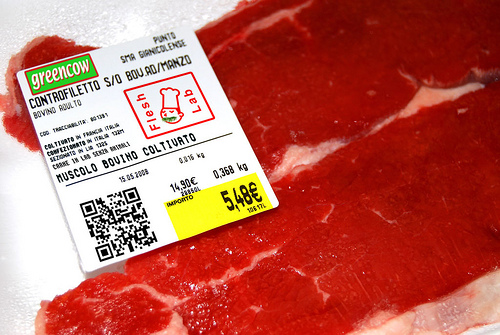By Sasha Moedt (The Cascade) – Email
Print Edition: February 29, 2012
The word Frankenburger is being whispered among scientists; an eerie attempt to create a mock-meat was unveiled last week. A test-tube patty made out of cattle stem cells was produced in an effort to create the very first in vitro meat. Mark Post of the University of the Netherlands has announced that the world’s first test-tube burger will be served up this October, according to Today. Expressions of disgust wash over consumers as descriptions reach ears: strips of beef muscle tissue flexed and relaxed by electrical stimulus to grow into a meat strip big enough to eat. Something pulsating in a lab? It’s like The Matrix for hamburgers.
To be honest, as a person who eats meat, I liked The Matrix. I thought, who cares if you’re in a tub of goo and wires and not actually living? It worked fine. And the same goes with test-tube burgers. I don’t have too much of an issue with eating something like that.
There are so many preservatives, additives and funny stuff added to an animal’s diet before slaughter, and then again to the meat after slaughter (which aren’t the choice cuts, that’s for sure), that I don’t see a problem eating test-tube meat. Both of them are fiddled around with a lot, and modified (genetically or otherwise) to taste like genuine meat. Let’s not kid ourselves; fast-food meat isn’t any safer to eat than these test tube burgers coming from Holland.
In 2008 PETA launched an initiative for scientists to make in vitro meat – and bring it to market. Mark Post has a burger for $220,000, but according to The Telegraph, it will only qualify for the million dollar prize once the product can be sold. The meat, according to PETA, must be sold at a competitive price (as compared to other meats) in no less than 10 states. It will also be judged by a panel of 10 PETA judges; the mock-meat must have a taste and texture “indistinguishable” from the real meat.
“More than 40 billion chickens, fish, pigs, and cows are killed every year for food in the United States in horrific ways,” PETA states, explaining their huge reward for this project. “Chickens are drugged to grow so large they often become crippled, mother pigs are confined to metal cages so small they can’t move, and fish are hacked apart while still conscious – all to feed America’s meat addiction.”
The idea of in vitro meat eliminates so many reasons to feel guilty about this “addiction” (which is a perfect term for it). There will be no more cruelty. The damages to the environment inflicted by us—the forests clear-cut to make space to graze cattle, the resources wasted—will all be gone.
Like I said, I eat meat. If I think about it, I don’t know how the chicken, cow, or pig was raised or what it was fed or how it was killed. What difference does it make if it’s grown like a bit of bacteria, cultured in a lab and, scientifically produced? It really is like The Matrix, except in this analogy, we’re the robots and the animals are the humans. We all know we can’t live the way we want to in the natural world the way we are. But still, we have to make some adjustments – I guess this is one way to go.


